![[SoundStage!]](../sslogo3.gif) The Y-Files The Y-FilesBack Issue Article |
| December 1999 A New Player at the Cable Game Table The following excerpt is from an existing cable manufacturer’s printed address, sent to me by a well-meaning and kind-hearted audiophile who couldn’t possibly know what embers in my taciturn psyche he was about to fan to explosive levels: "… The traditional measurement of capacitance, inductance and resistance no longer matter. These values have been reduced to negligible levels in our cabling and thus have become a non-factor. Many other wire products proclaim these traditional criteria as justifications for their design, advertising how low their measurements are compared to the rest of the marketplace. We have displaced these traditional standards…" [emphasis by manufacturer] A bit further down in this treatise we find that: "...as the transition from electrical disruption to uniformity occurs, energy efficiency increases, audibly resulting in improved power and resolution. At this point, our designs initiate room temperature super-conductivity, perhaps a first in audio…" Hmmm. Or perhaps I should say ho-hum and clear my throat before I get mad. You see, subjective claims per se are not intrinsically bad. Had this designer merely stated that his cables were the best-sounding in the world and then invited me, the reader, to rush out and have a listen for myself, I’d probably already be on the phone to order a demo set. Instead, he quotes scientifically measurable parameters of electrical conductors and claims that he has entirely transcended them. Conveniently, he fails to mention, in the same scientifically acceptable terms, how he has wrought this miracle. Magic, abracadabra and then "poof," inductance, capacitance and impedance vanish in thin air, never to be heard from again? I don’t know about you, but I find this kind of rampant, pseudo-techno babble obnoxious to the extreme. Maybe horsehair coated with cow dung does indeed a superior conductor make. But anyone who dares claim such outrageousness better be prepared to prove it with oscilloscope and spectrum analyzer before the scientific community -- or anyone with common sense -- lashes his back with a whip made from the same horsehair, albeit heavily clad in sun-baked bullshit. No wonder the audiophile industry at large appears to most levelheaded scientists and honest engineers like a disinherited offspring from an illicit affair between unaccredited tinkerers and New Age necromancers. For reasons unbeknownst to me, audiophiles are supposed to swallow such poppycock without batting an eyelash. Worse, they are expected to part with obscene amounts of money for "inventions" that miraculously line up electrons to march in sync rather than mosh in Woodstock fashion to the irregular beats of chaos; or promise groundbreaking sonic improvements which are only audible after three months of excruciating, mind-numbing aural acrobatics. This is not to discount novel, unconventional solutions arrived at via "esoteric" thinking, but the current air of voodoo that wafts around many matters audiophile would clear up to everyone’s benefit if only claimed results were more substantially documented. If two encased polymer shafts are said to damp parasitic resonance in a cable, why not include measured proof that shows the reduction of such resonance and how it alters the effects on the signal? While we’re on the subject of cables and subjectivist claims, let me introduce you to a team of folks who’d probably find the above quotes equally questionable, grotesque and in poor taste. Better yet, they have the credentials, experience and equipment to measure and substantiate most scientific claims made on the subject of cables. Some personal history first:
Fellow Michigan grad Dr. Sun, Ph.D. is Analysis Plus’ second principal (seated right in photo). His undergraduate work took place at Wuhan University of Technology in China after which he worked on projects for the US Naval Surface Warfare Center, Oak Ridge National Laboratory and a variety of other technological and manufacturing laboratories including the Power Center of Tennessee Technological University.
Analysis Plus Inc., formed in 1993 by Markel and Sun, is a high-tech consulting firm that provides leading-edge research and technology in the field of electronic systems and components to major corporations. Amongst its clients are Boeing, NASA, Motorola and a number of high-end-audio and home-theater manufacturers whose names are non-disclosure material, but a DVD project is currently in the works. What’s all this got to do with my opening rant against subjectivist cable claims? Simply this: a well-known and very established cable manufacturer who shall remain nameless hired Analysis Plus to perform state-of-the-art measurements on his own designs. When the three engineers duly informed him afterwards that his products were significantly flawed and produced detailed measurements to prove their findings and a solution to overcome the designs’ shortcomings, doors closed and they found themselves turned down. Subsequent testing of other well-known audiophile cable brands confronted our intrepid scientists with further evidence that proper data grounded in verifiable testing procedures was conspicuously absent in most cable advertising claims. Furthermore, they were told repeatedly that what’s currently peddled as the state of the art, even though measuring poorly according to Analysis Plus’ testing methods, was good enough for the existing players to continue doing business as usual. Our three Musketeers convened and the rest is, as they say, history. With their rejected solution in hand, Analysis Plus went to the patent office, the patent was granted and they’ve been in the cable-manufacturing business ever since. Before we proceed further, let’s inspect the following "molecular" chain as it could just prove to be one possible antidote for the subjectivist’s claims virus that continues to make my blood boil: NASA, Boeing, Motorola, US Naval Surface Warfare, CIA, US Air Force Phillips Laboratory, high-end audio cables, patent office. Think about this: anytime the military or NASA is involved, discoveries become so cutting-edge and applied research so intense, the general populace finds out ten years later when materials or processes become declassified for tax-paying civilian consumption. If something works for the military or space travel, chances are it’s good enough for us. If somebody is hired as outside contractor to these governmental agencies, chances are excellent he’s an expert in his respective field, even if it’s the manufacture of gold-plated toilet seats. Add to this a patent -- how many new, as yet
undiscovered ways could there possibly be left to twist a cable to have a patent granted
days before the new millennium? What could top-level scientists with access to
sophisticated modeling software and unquestioned experience in the electromagnetic R&D
field bring to the audiophile cable industry that has eluded our best cable manufacturers?
What could the competition have overlooked that these three gents from Michigan stumbled upon? Before we look at construction details of the Analysis Plus cables, let’s reflect briefly on the complexity of any given problems and how different solutions address different effects, not necessarily the root cause. Dropping a rock into water is what causes ripples. Each subsequent ripple is a result of the one preceding it. If waves are to be prevented, addressing the second or third ripple -- higher-order effects -- won’t do, but the rock thrower himself has to be dealt with. Invite him to dinner. Once inside the bistro, the best ingredients don’t a memorable soup make if the cook is lousy. Throwing more money at his spice collection or ordering seconds doesn’t remedy the problem. The cook needs to be fired or go back to the culinary institute. To get back to cables, conductor geometry that is intrinsically flawed and causes signal aberrations won’t drastically mitigate its negative impact on the signal when common conductor materials are swapped out for esoteric ones or boxes with passive components added. A dedicated loudspeaker cable acts as a signal transmitter between what are essentially impedance-mismatched components -- amplifier and speakers. According to Analysis Plus, minimizing this inherent mismatch is addressing a primary effect rather than worrying unduly about second- and third-order effects. While undoubtedly real, these higher-order effects -- such as dielectric energy storage -- have a much lesser impact on the overall picture, very much like the third wave of our earlier rock-throwing example, which is of a lesser magnitude than the first or second wave. The cited basic impedance mismatch between amp and speakers is further compounded by a loudspeaker’s erratic impedance curve that varies with frequency despite its nominal rating, which really is merely an average value that often hides severe dips and peaks. Put simply, a speaker’s impedance is a moving target. To add further complexity, a traditional round conductor isn’t a fixed value either as it increases its characteristic resistance with frequency due to skin effect. Rising frequencies diminish current density. Most of the center of the conductor is bypassed so that the majority of high-frequency signal content propagates only along the conductor surface. This effect is multiplied in the common cylindrical two-conductor designs where source and return-current conductors are merely separated by a dielectric. The bi-directional current flow causes current bunching when the magnetic fields of source and return current "pull" on each other. This again reduces current flow in most of the actual conductor mass except for the area in close proximity to the parallel conductors. Hence this type of interaction is known as the proximity effect. It again causes resistance to increase with rising frequencies, making signal propagation more inefficient. The designs most successful at addressing current-density effects are rectangular-solid-core conductors, usually one-piece flat ribbons. Solid-core conductors, however, are highly susceptible to kinks, which, when measured under a time-domain reflectometer, reveal impedance mismatches and internal reflections. While the Analysis Plus engineers found much to admire in such designs, they set out to build upon their strengths and eliminate their weaknesses. When our three Musketeers began work on their cable design, they had done extensive testing on existing high-end cables. Measuring a sine-wave-generator-created square wave with an oscilloscope at the cables’ outputs, they kept measuring response curves that looked nothing like their input square-wave shape. Bent on rectifying such a basic design flaw, they relied heavily upon sophisticated computer simulation software to explore the actual properties of different cable geometries under real-world application without having to construct expensive and time-consuming prototypes. They were also aiming at increasing a cable’s transfer efficiency. This simply meant they wanted to minimize or eliminate skin effect so that all their cable’s conductor mass would be used at all frequencies. Pop quiz. If electron flow migrates outwards with rising frequency and bypasses the conductor’s center, why not eliminate the center entirely and build a hollow cable? Our practically minded engineers immediately realized that a round hollow cable couldn’t be bent without changing its basic shape. This would immediately alter its inherent characteristics. Undaunted, they commenced to take turns jumping up and down upon their hollow-round idea. Finally, after endless nights of mental assaults, the round shape succumbed to listener fatigue, suffering the countless knocks of persistence. It relaxed into an elongated hollow oval. Believe it or not, but that hollow-oval shape, in conjunction with a unique braided pattern that statistically places every wire as close as possible to the return current as every other wire, is what the US patent office had never come across before and consequently awarded a patent for. Our three Musketeers reasoned that to overcome a solid conductor’s inherent liability for mechanical stress when bent, a braided pattern would prove more resilient and flex back into its original shape. Hence that’s exactly what they went with. Because I’m not an engineer, I’m ill equipped to investigate thoroughly and verify the numerous graphs that the designers at Analysis Plus have available to show the electric behavior of their cables under different test conditions. The various plots do seem to corroborate succinctly their claims that the braided hollow-oval design minimizes characteristic impedance fluctuations and skin effect, which makes their cables more constant and efficient in behavior. When Steve Pennock takes cables on the road for dealer demonstrations, he carries with him a Hewlett-Packard oscilloscope amongst other tools of the trade. He is not averse to plugging in any competitors’ cable that might be on hand, either. Before any listening commences, he wants to ensure his audience understands that the Analysis Plus designs are based on solid, empirical science and test procedures that anyone with access to the proper equipment can readily duplicate and verify.
The Silver Oval, besides the obvious plating which is plainly visible through the transparent shield, differs from the other two models by placing the source and return-current legs inside each other, whereas the all-copper versions sandwich both conductors atop one another similar to the well-known Alpha-Core designs. Custom spades machined from massive solid-copper blocks with silver plating feature dual-screw sockets that allow for either in-line or right-angle terminations. For an upcharge of $50 per cable pair, patent-pending stamped silver-solder connections are available. This is the very best termination of all because it eliminates the connector-cable interface entirely. It’s literally a bare-wire spade that is stamped out of the actual conductor, then treated with silver solder for mechanical integrity. Three-conductor hollow oval interconnects called Oval-In will be available by the time this article goes public. All cable types are already available in 250' bulk rolls. Before I go offline this month, I want to tell you about the actual manufacture of this unusual and handsome cable that has now graced my listening room for quite an extended evaluation. By the way, another reviewer, famed sailboat designer Bob Perry of The Audiophile Voice, was listening to the Oval Nine before I had ever heard of it. It was he who hipped me to Analysis Plus and had Steve Pennock give me a call out of the blue. I nearly didn’t return the call because the name Analysis Plus sounded to me as though the feds had found a new and sinister way to examine my tax records ever more scrupulously. I’m very glad my curiosity prevailed instead. A big thanks to Bob! Back to the actual making of the cables. Mark Markel duly informed me that because of his prior work in medical electronics, he managed to contract with a company called New England Electric Wire Corporation in Lisbon, New Hampshire. This company manufactures specialty wire for medical, aerospace, nuclear-fusion-research and high-energy-physics use and was the only company he solicited that proved capable of building the Analysis Plus designs to exacting specifications. Mark dryly commented that he found out the long way why most companies use round wire: it’s a heck of a lot cheaper to manufacture and a lot easier to terminate and strip. The latter fact caused Dr. Sun’s parents, both of whom are engineers, to design special cable strippers and a manufacturing flow for Analysis Plus’ unique geometry. Still, each cable takes about one hour of crafting. Looking at the retail price table, I remain puzzled how they can sell these cables so affordably, especially knowing how much by-hand labor goes into each one.
...Srajan Ebaen
|
|
![[SoundStage!]](../sslogo3.gif) All Contents All ContentsCopyright © 1999 SoundStage! All Rights Reserved |
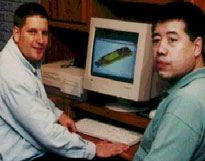 Mark Markel (seated left in
photo at right), one of three principals at Analysis Plus, holds bachelor’s degrees
in both physics and electrical engineering, as well as a master’s degree in
electrical engineering, all from the University of Michigan. One of his post-graduation
projects included a two-year mission to construct a spectrum analyzer to measure the power
and frequency of pulsed plasma for a magnetic mirror machine. He then entered the
automotive community and did vehicular electromagnetic analysis and electrical simulations
for one of the largest car manufacturers in the world.
Mark Markel (seated left in
photo at right), one of three principals at Analysis Plus, holds bachelor’s degrees
in both physics and electrical engineering, as well as a master’s degree in
electrical engineering, all from the University of Michigan. One of his post-graduation
projects included a two-year mission to construct a spectrum analyzer to measure the power
and frequency of pulsed plasma for a magnetic mirror machine. He then entered the
automotive community and did vehicular electromagnetic analysis and electrical simulations
for one of the largest car manufacturers in the world.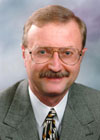 Steve Pennock, third
Analysis Plus man from the U of M, graduated with BSEE and MSEE degrees -- special
emphasis in electromagnetic courses -- and worked in the Engineering Research Division at
Lawrence Livermore National Laboratory for 12 years. His responsibilities included both
field experiments and computer simulation of EMP, high-power microwave, EMI and other
electromagnetic phenomena in the form of contract work for NASA Langley Research Center,
US Air Force Phillips Laboratory, Department of Energy, CIA, SLAC and the Naval Ocean
Systems Center. He later represented Ansoft Corp. and their high-frequency electromagnetic
modeling software as well as their circuit-simulation packages, and he has repeatedly used
his engineering software expertise to help validate new computer algorithms.
Steve Pennock, third
Analysis Plus man from the U of M, graduated with BSEE and MSEE degrees -- special
emphasis in electromagnetic courses -- and worked in the Engineering Research Division at
Lawrence Livermore National Laboratory for 12 years. His responsibilities included both
field experiments and computer simulation of EMP, high-power microwave, EMI and other
electromagnetic phenomena in the form of contract work for NASA Langley Research Center,
US Air Force Phillips Laboratory, Department of Energy, CIA, SLAC and the Naval Ocean
Systems Center. He later represented Ansoft Corp. and their high-frequency electromagnetic
modeling software as well as their circuit-simulation packages, and he has repeatedly used
his engineering software expertise to help validate new computer algorithms.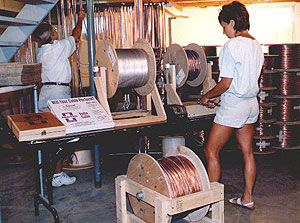 This becomes even
more confounding when you consider that the Analysis Plus cable designs employ ordinary or
silver-plated copper, not some hyper-expensive alloy or unobtainium never before
considered as electrical conductor. If the conductor or dielectric material is
subtracted from the equation, the only significantly modifiable element left is geometry.
Of course, round, twisted, braided, helixed, solid-core, rectangular-solid-core,
flat-solid-ribbon, woven-ribbon, parallel-flat-rectangular-solid-core cables and any
combinations thereof have been manufactured for years. The plot thickens when you find out
that a 10-foot pair of terminated Analysis Plus speaker cables, depending on grade, sells
for between $175 and $600, the latter terminated with custom spades machined from a solid
block of copper and finished with a silver plating. This is hardly within the realm of
cost-no-object audiophile arcana.
This becomes even
more confounding when you consider that the Analysis Plus cable designs employ ordinary or
silver-plated copper, not some hyper-expensive alloy or unobtainium never before
considered as electrical conductor. If the conductor or dielectric material is
subtracted from the equation, the only significantly modifiable element left is geometry.
Of course, round, twisted, braided, helixed, solid-core, rectangular-solid-core,
flat-solid-ribbon, woven-ribbon, parallel-flat-rectangular-solid-core cables and any
combinations thereof have been manufactured for years. The plot thickens when you find out
that a 10-foot pair of terminated Analysis Plus speaker cables, depending on grade, sells
for between $175 and $600, the latter terminated with custom spades machined from a solid
block of copper and finished with a silver plating. This is hardly within the realm of
cost-no-object audiophile arcana. 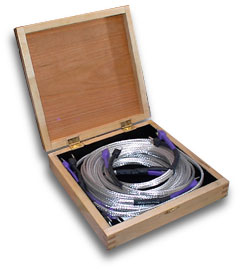 Three different
speaker-cable models are currently available: the top-of-the-line silver-over-copper
Silver Oval with a gauge of 12, and the all-copper Oval 9 and Oval 12.
Three different
speaker-cable models are currently available: the top-of-the-line silver-over-copper
Silver Oval with a gauge of 12, and the all-copper Oval 9 and Oval 12.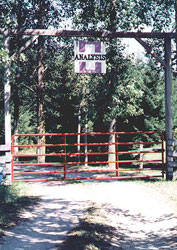 You realize
I’ve remained mute about the cables’ sonic performance. That’s quite
intentional even though I must confess to itching. This monthly column is not intended to
replace our formal SoundStage! audio reviews. For that, you’ll just have to
wait for something to appear in our regular Audio Online site. Given that my exposure to
the people behind the product might have unduly influenced my perceptions, a feature
review is best left to one of our many capable reviewers. But rest assured that I
wouldn’t bother introducing a new cable company in this space if I didn’t
believe this product to merit serious consideration. Here is a new outfit without any
esoteric pretensions whatsoever. Conversely, they offer rock-solid engineering savvy, a
firm grasp on the science behind the hoopla, and intimate access to high-tech gear the
actual use of which might confound a lot of competitors. Let’s just hope our
audiophile circus won’t disappoint their expectations. Check out
You realize
I’ve remained mute about the cables’ sonic performance. That’s quite
intentional even though I must confess to itching. This monthly column is not intended to
replace our formal SoundStage! audio reviews. For that, you’ll just have to
wait for something to appear in our regular Audio Online site. Given that my exposure to
the people behind the product might have unduly influenced my perceptions, a feature
review is best left to one of our many capable reviewers. But rest assured that I
wouldn’t bother introducing a new cable company in this space if I didn’t
believe this product to merit serious consideration. Here is a new outfit without any
esoteric pretensions whatsoever. Conversely, they offer rock-solid engineering savvy, a
firm grasp on the science behind the hoopla, and intimate access to high-tech gear the
actual use of which might confound a lot of competitors. Let’s just hope our
audiophile circus won’t disappoint their expectations. Check out